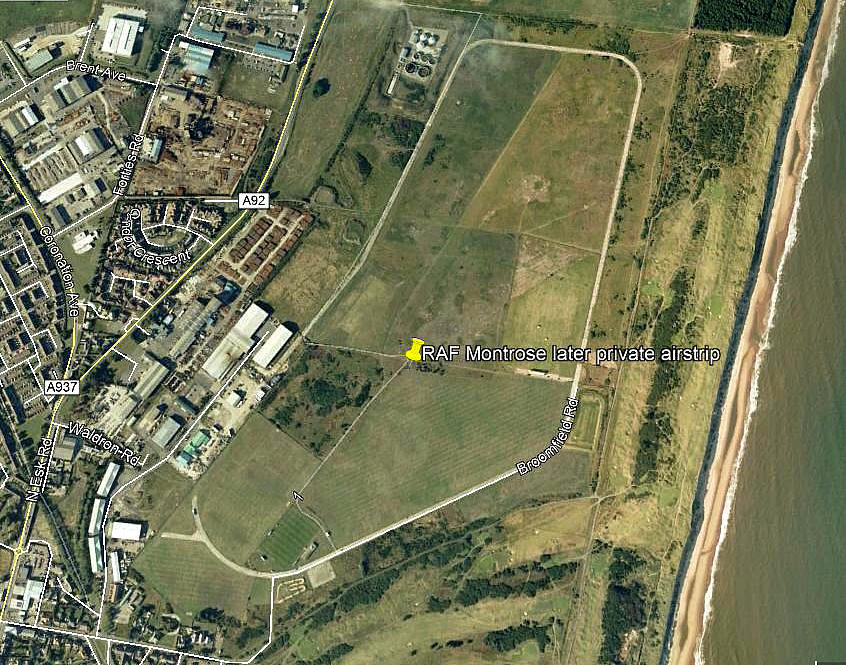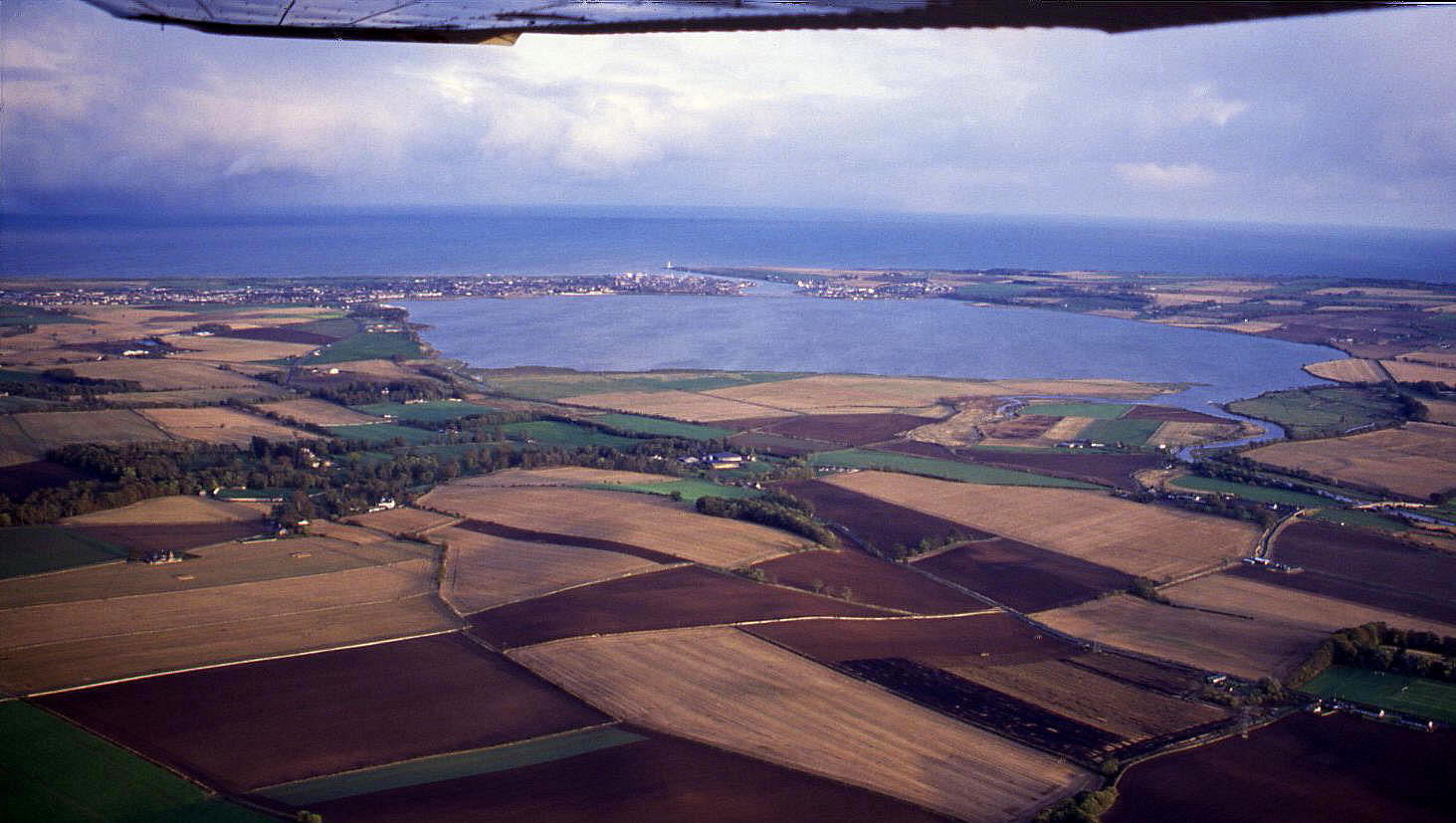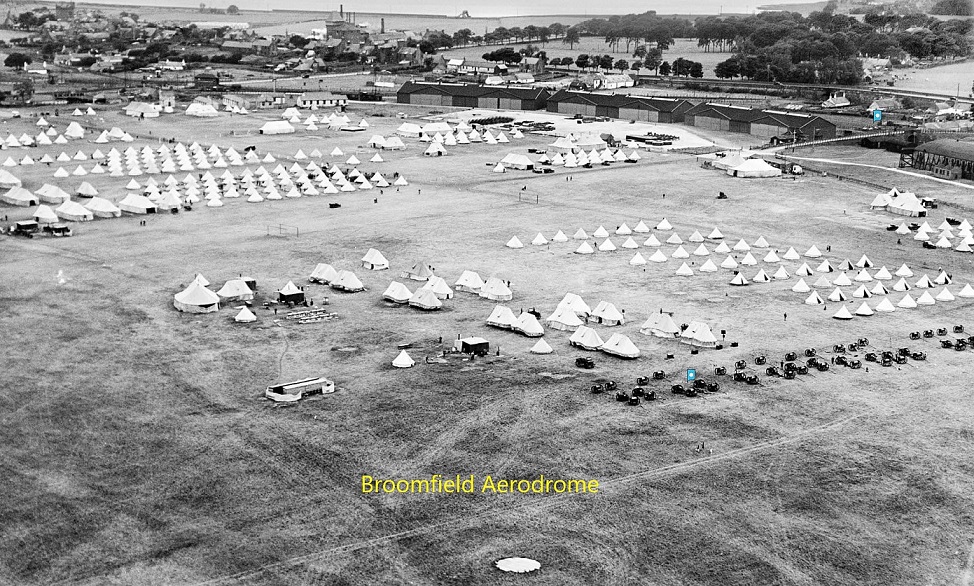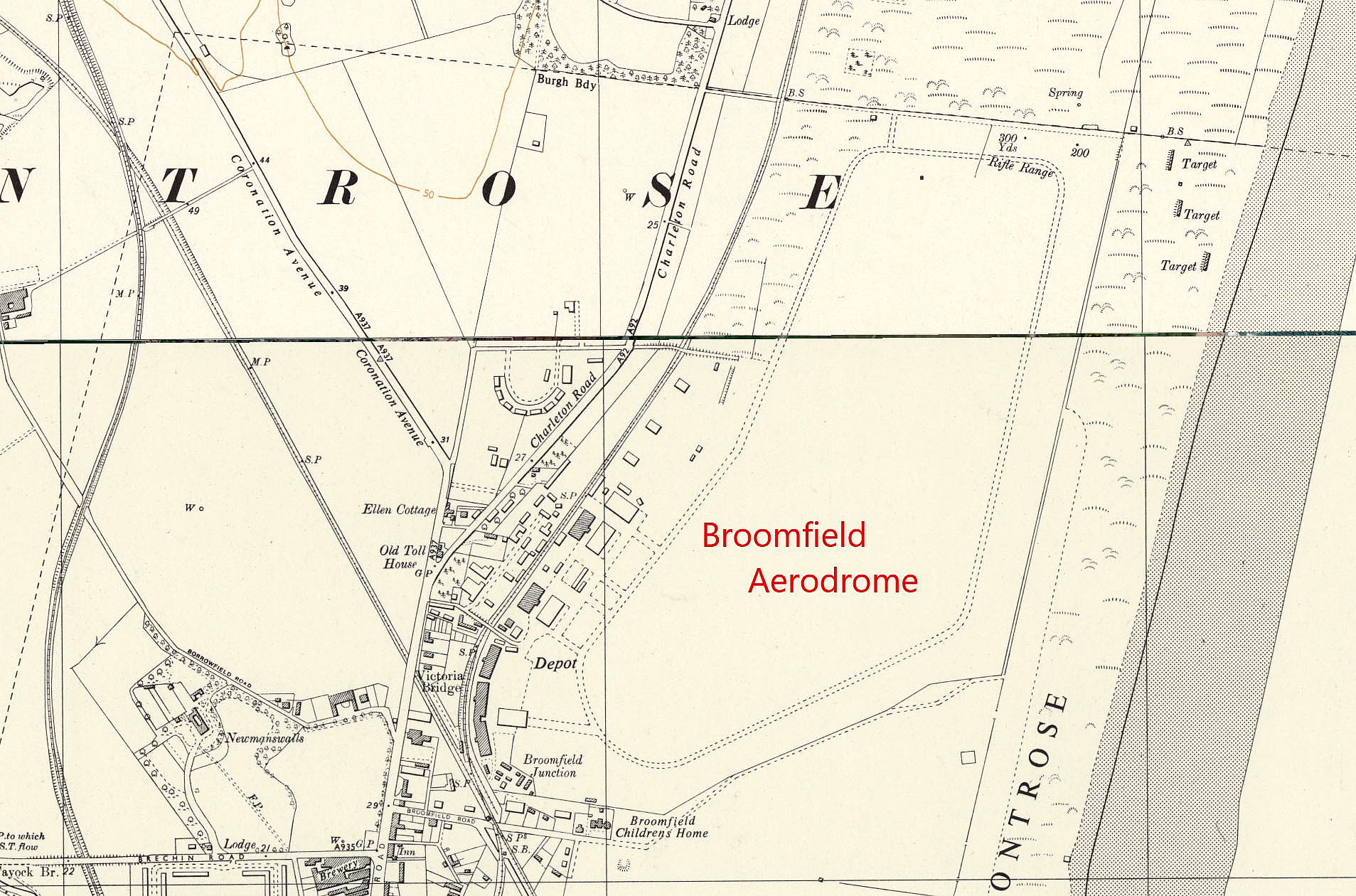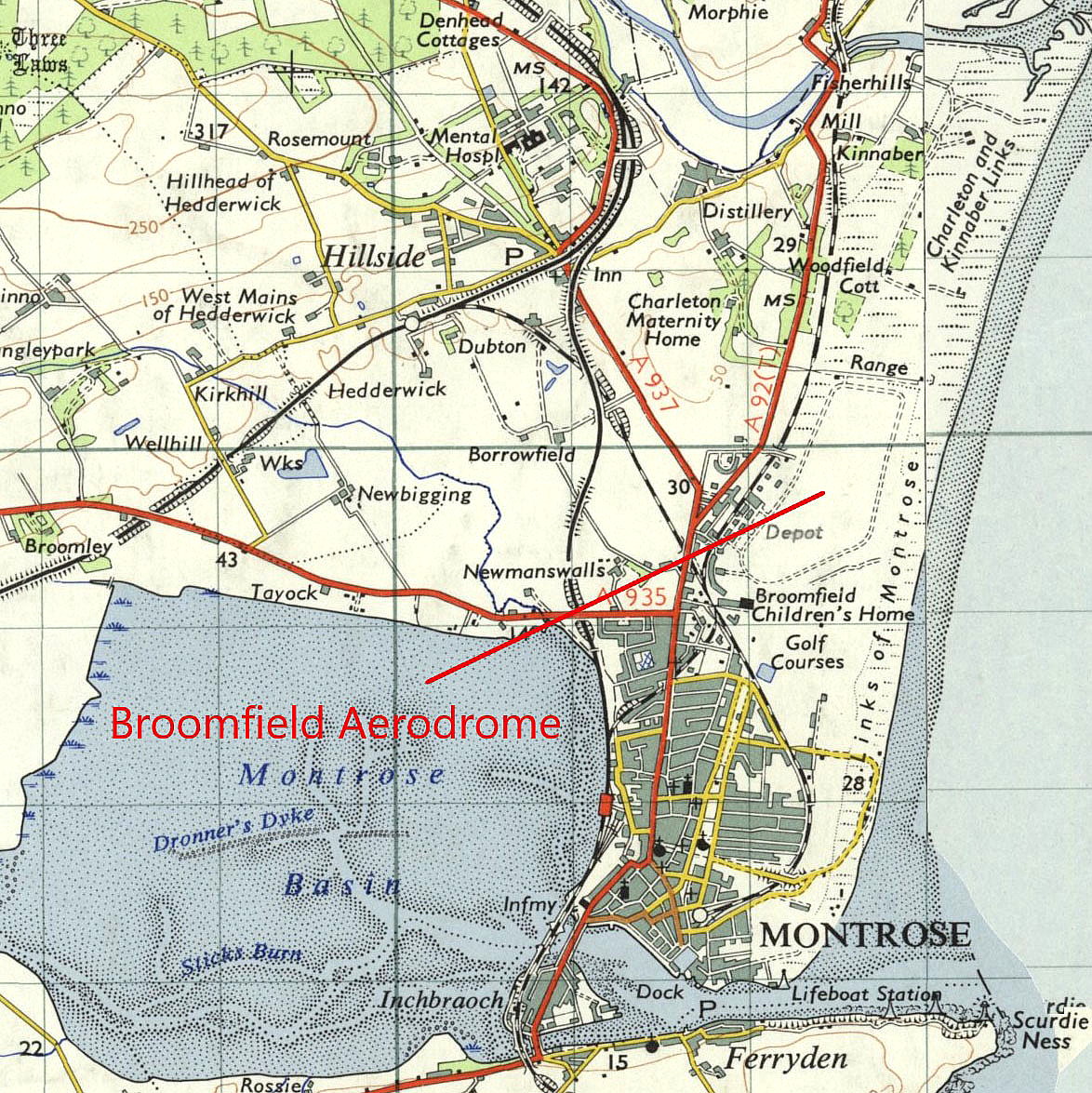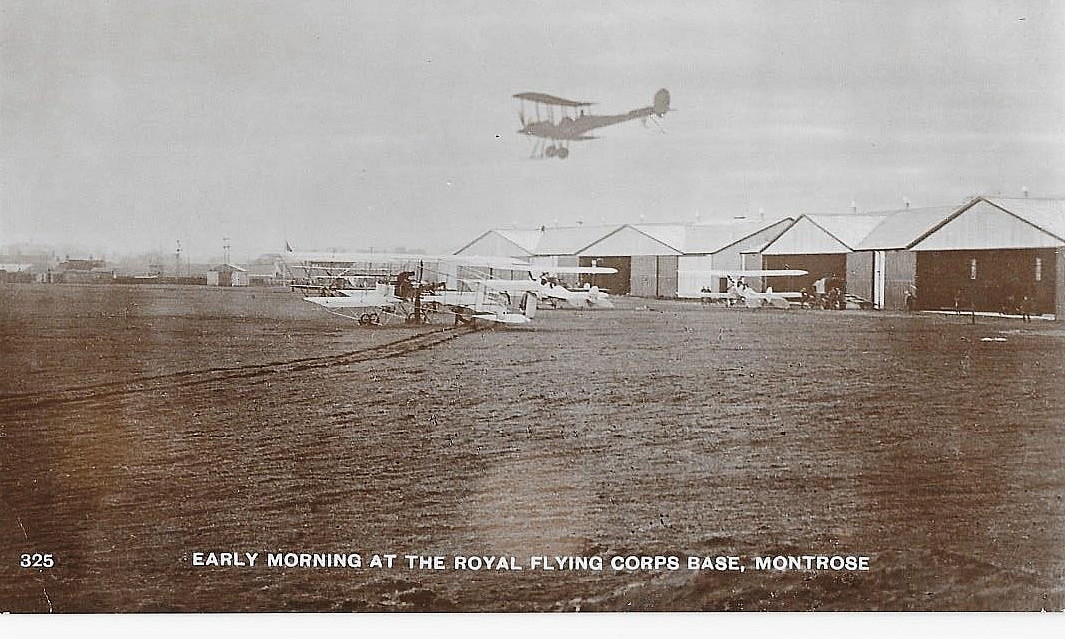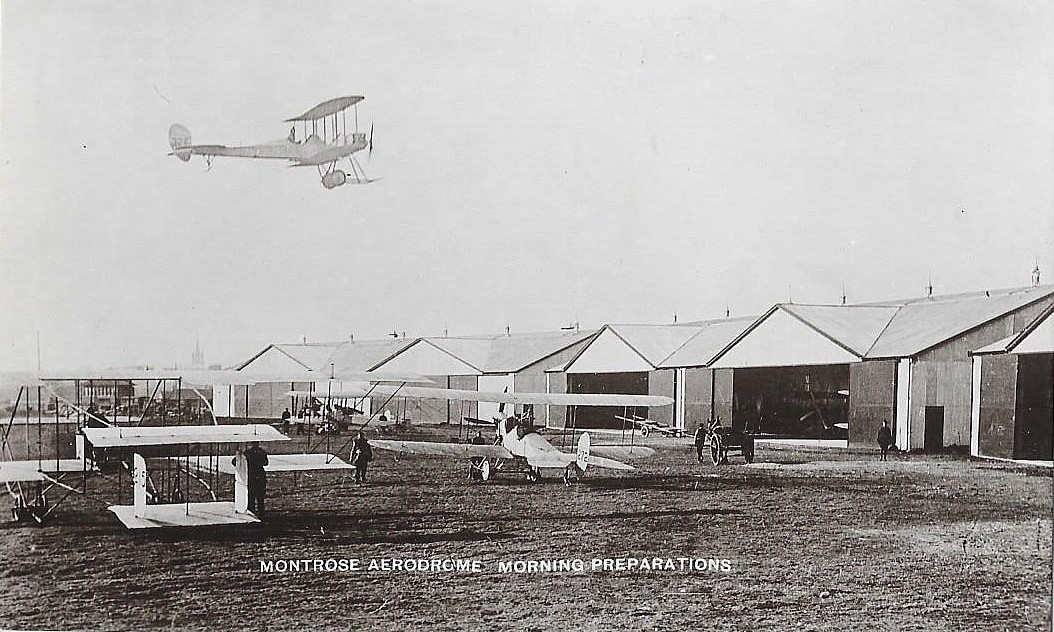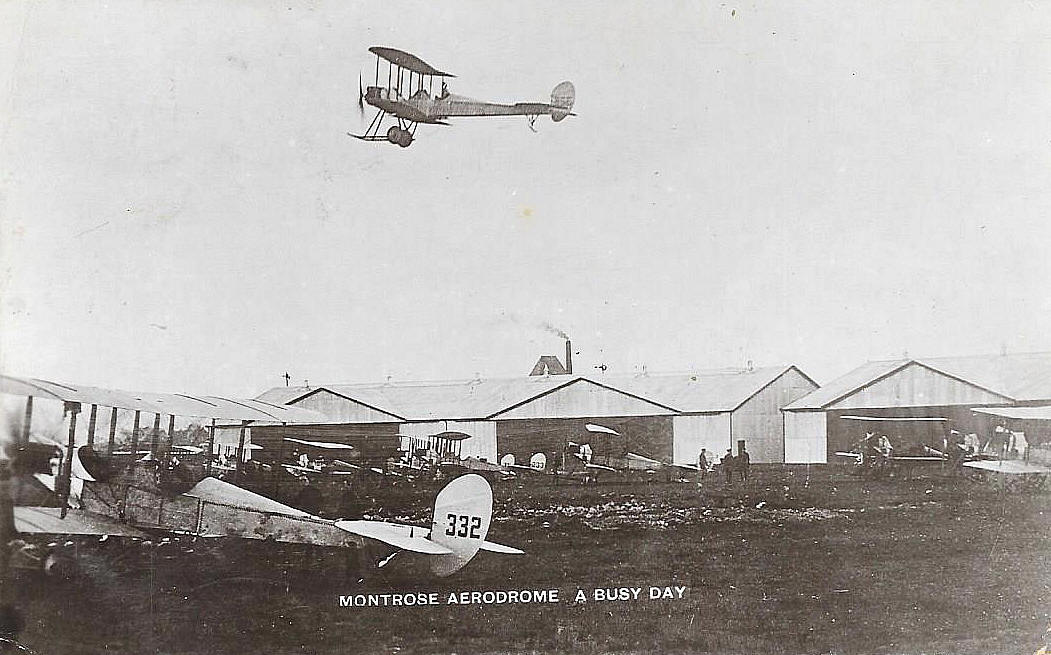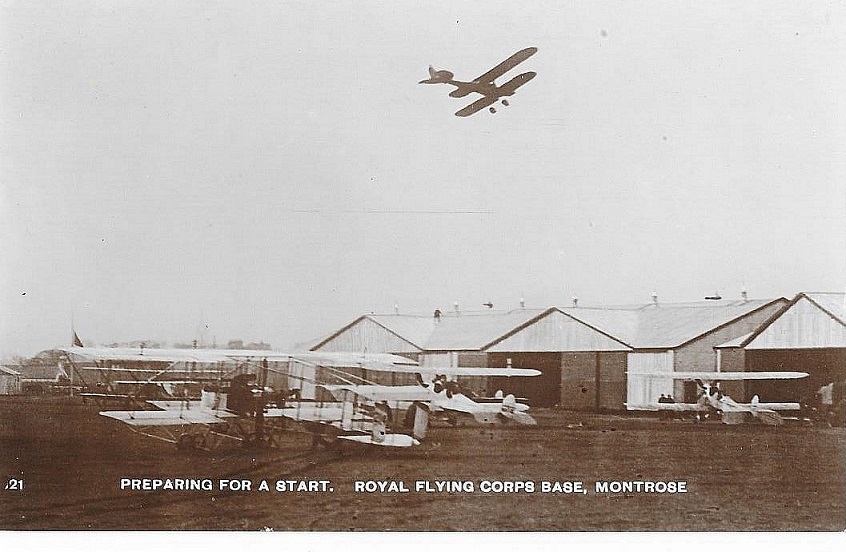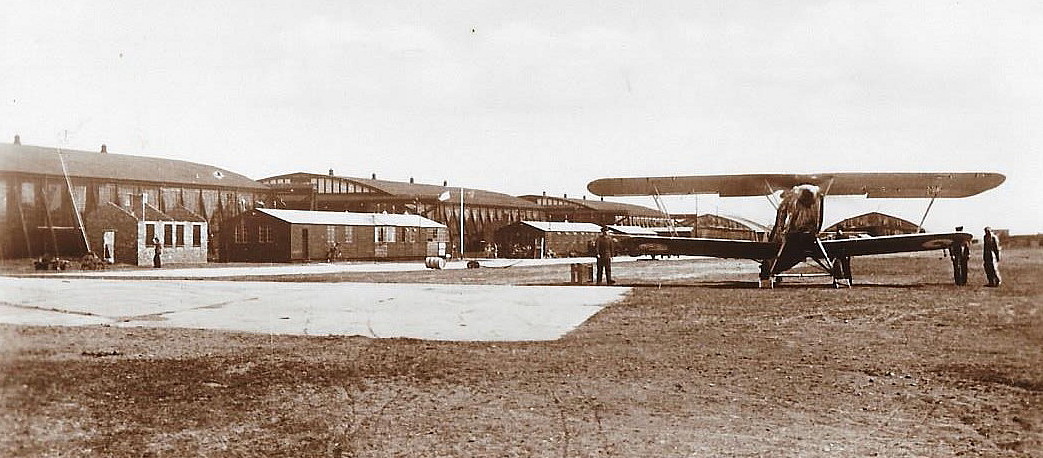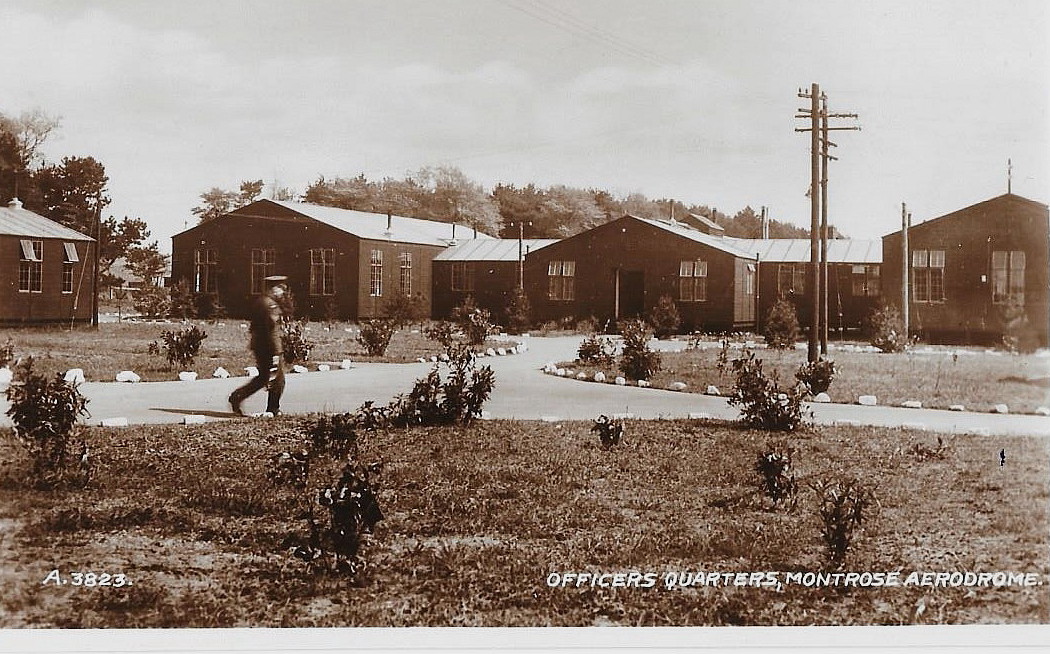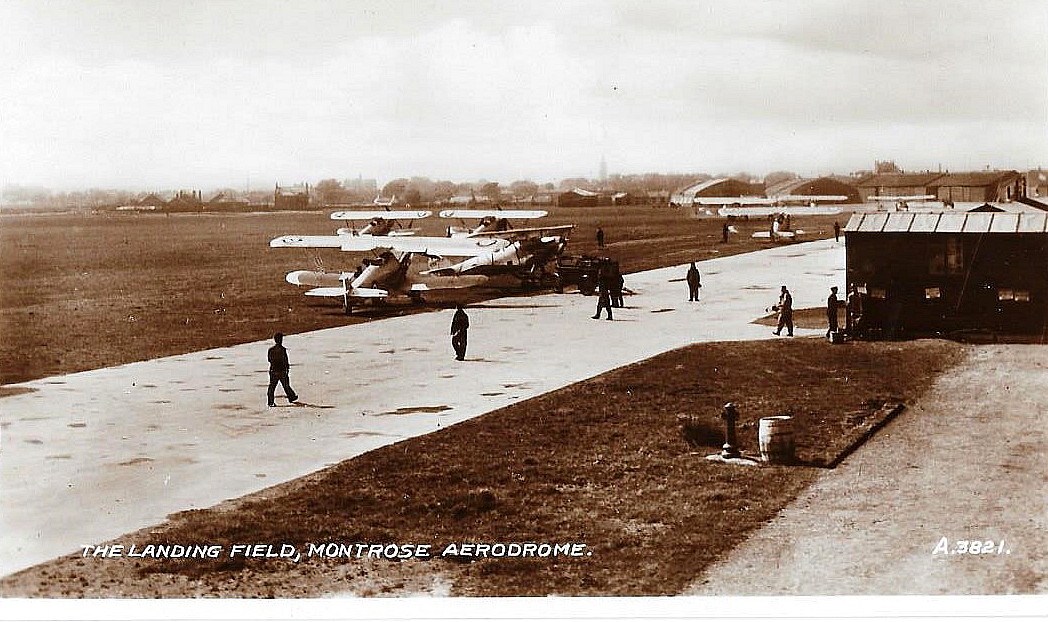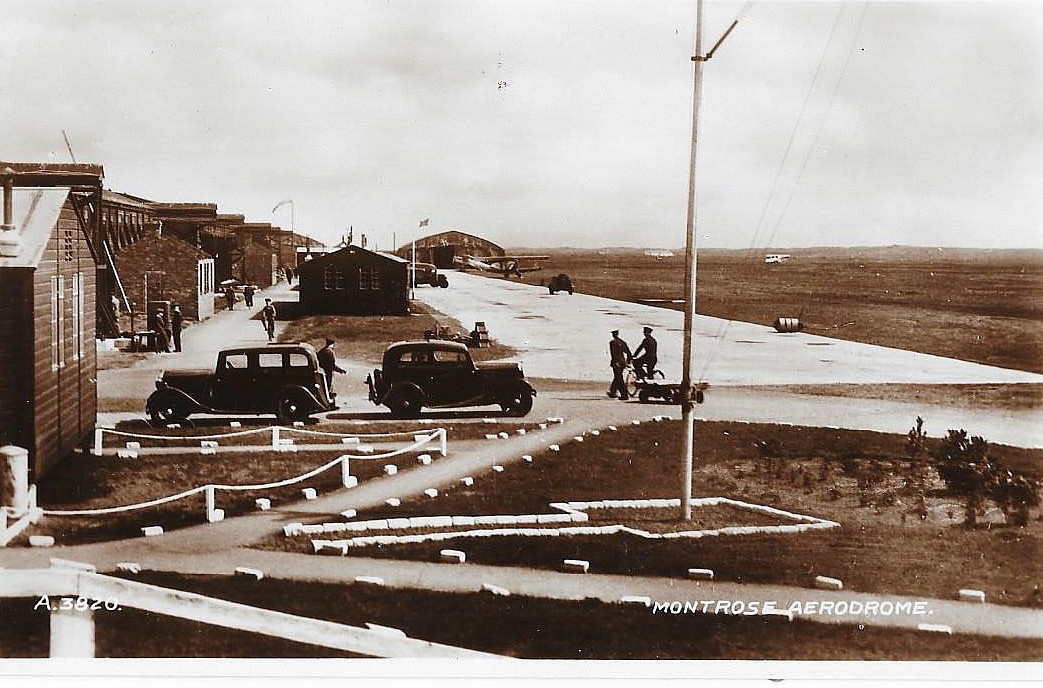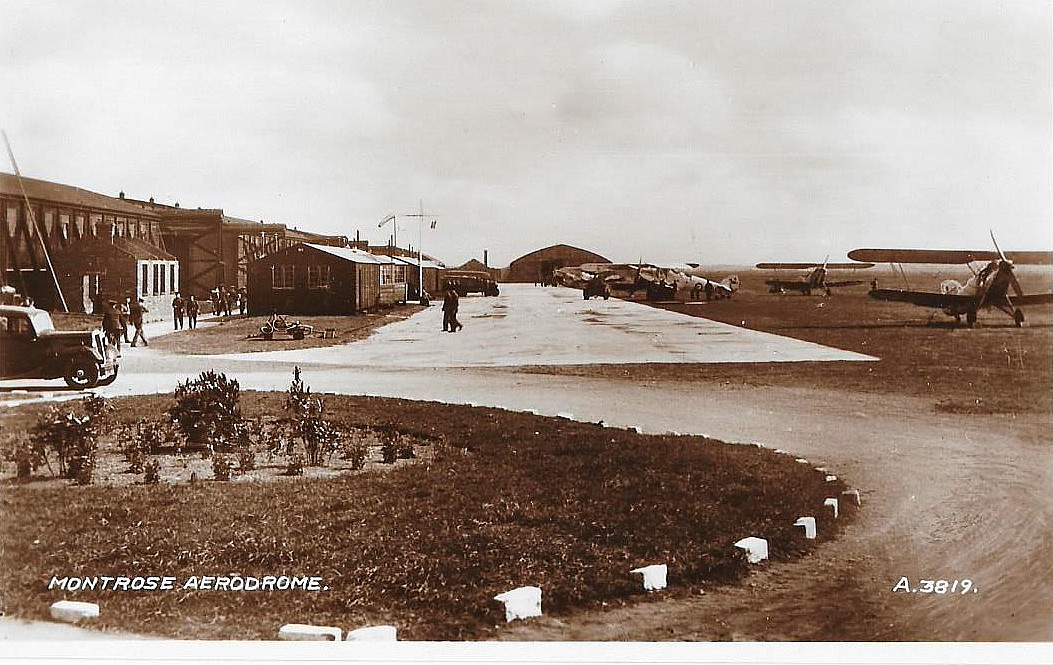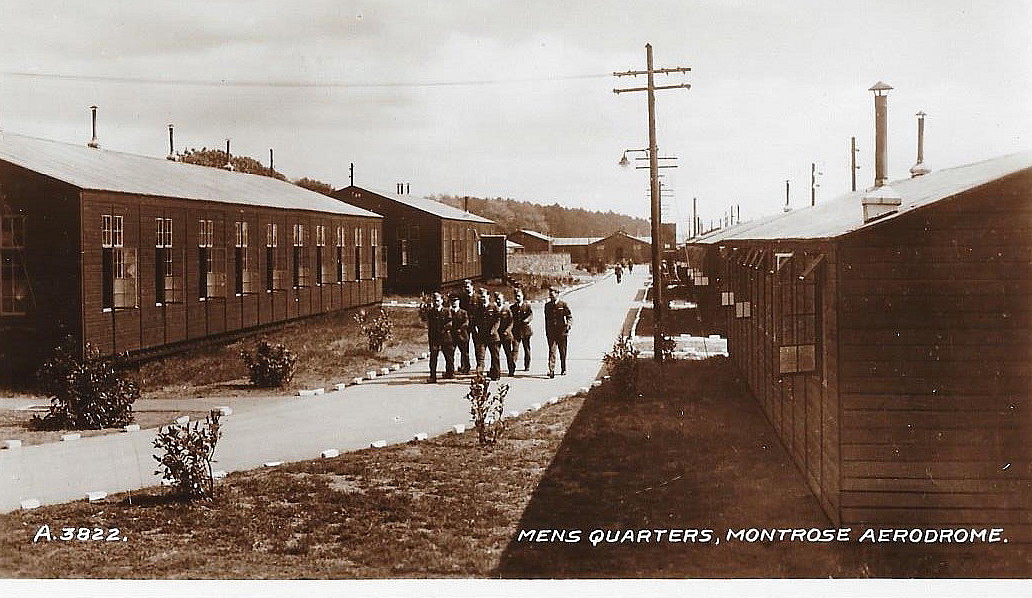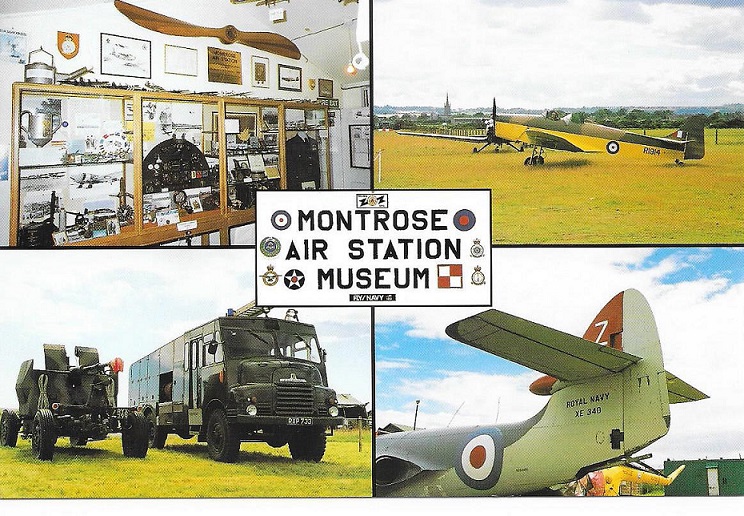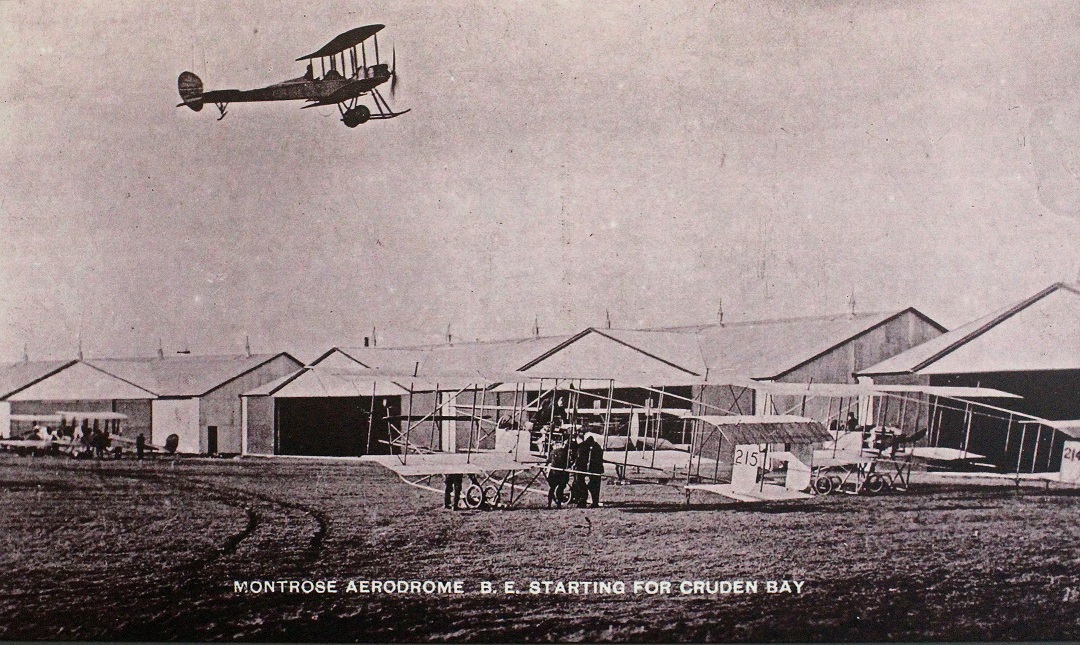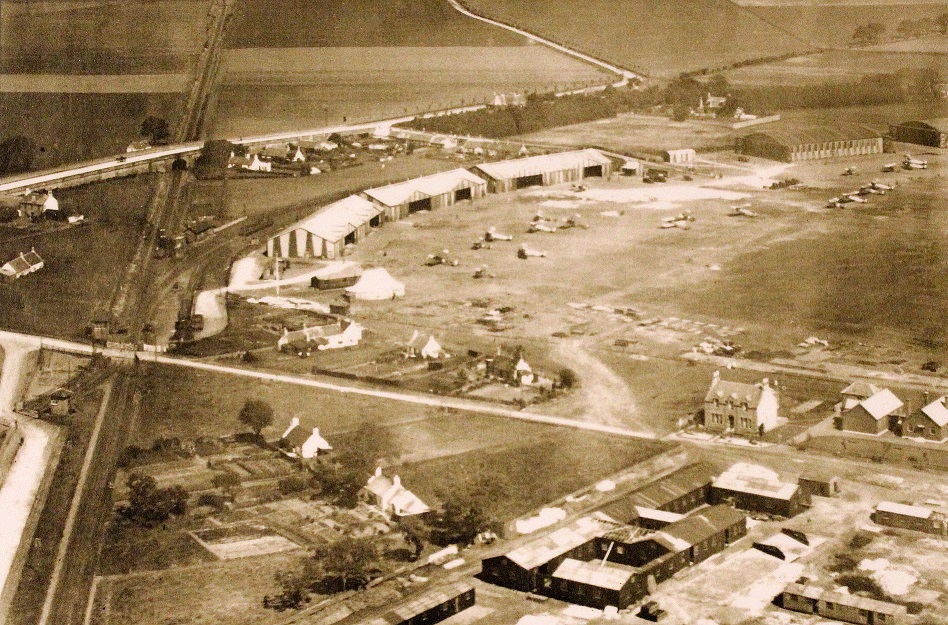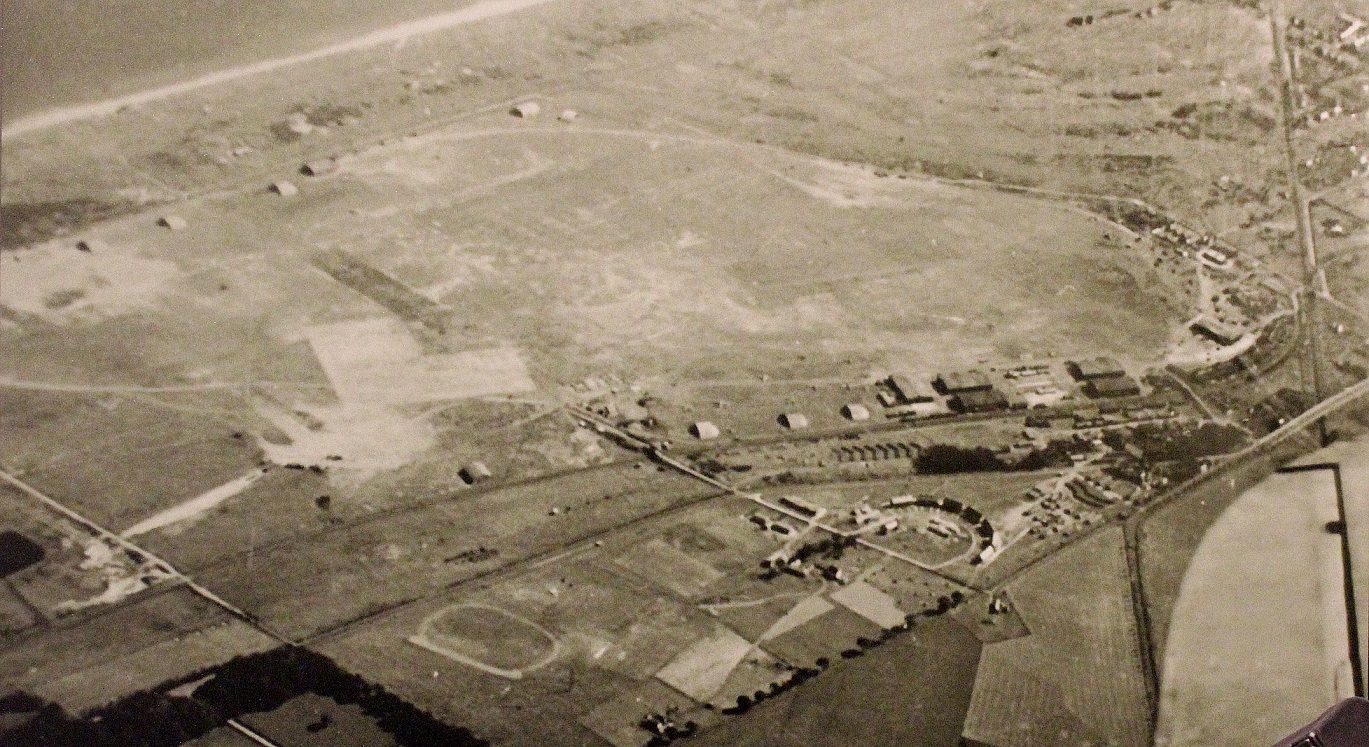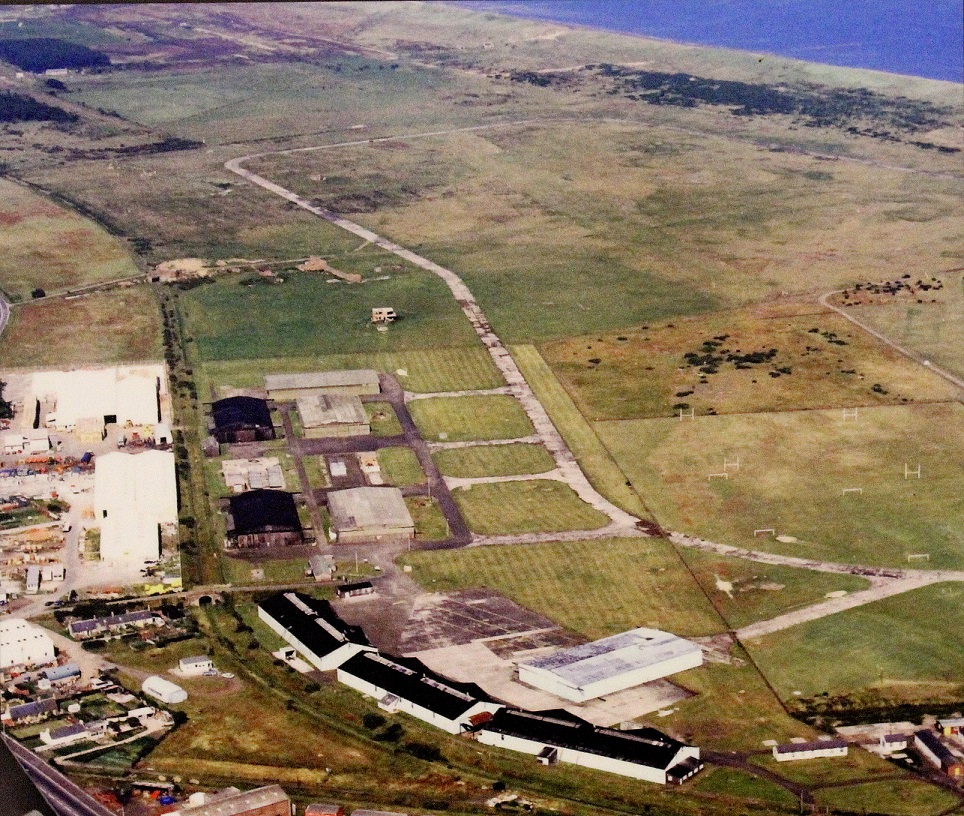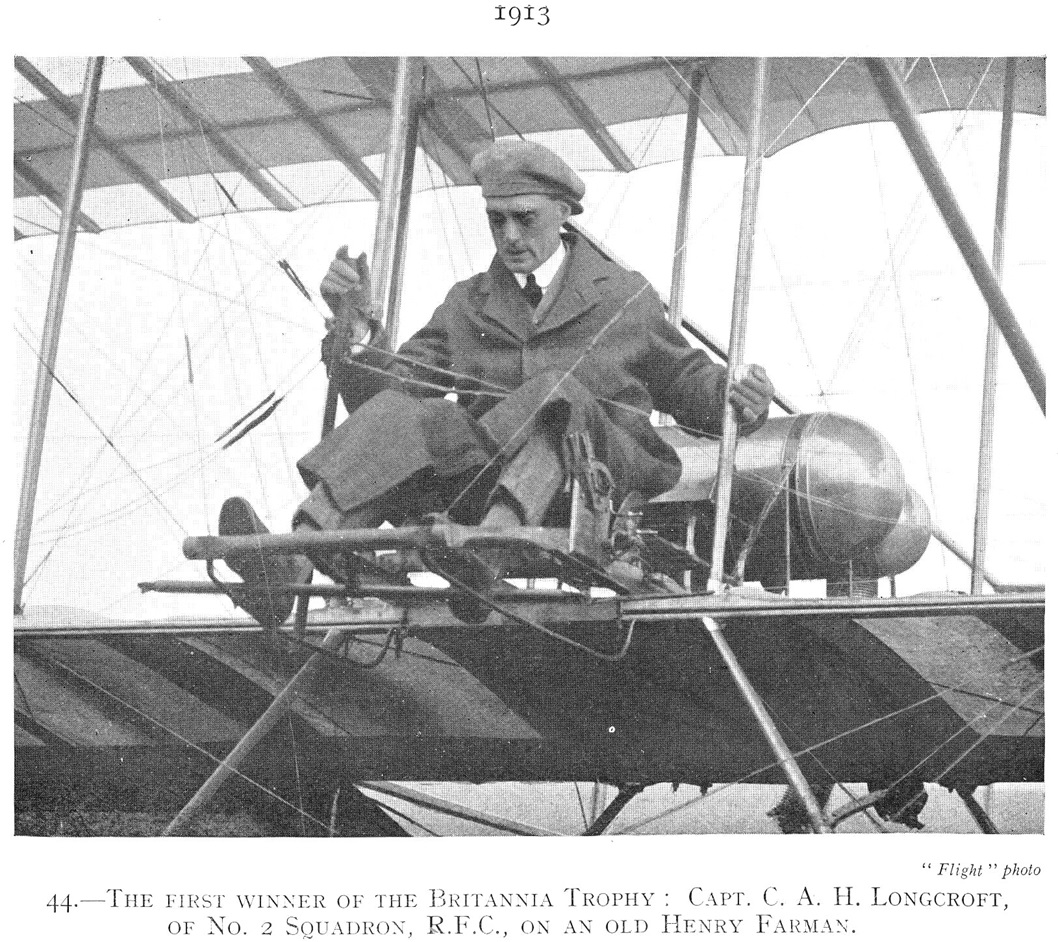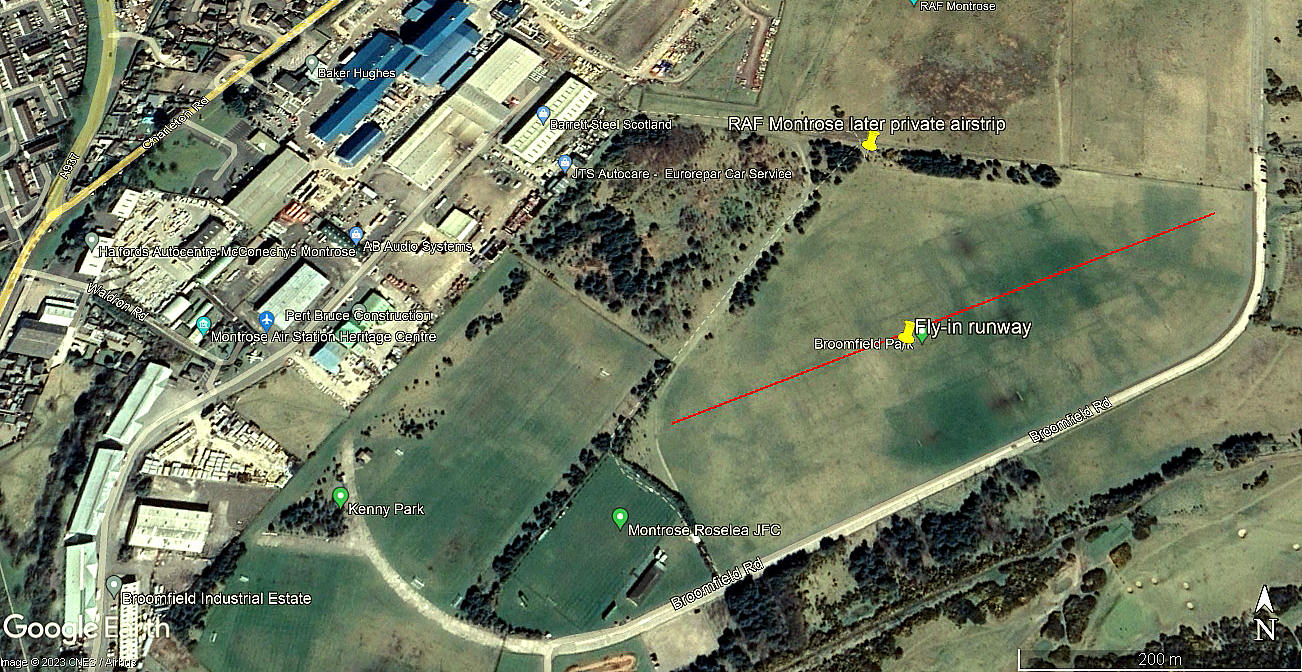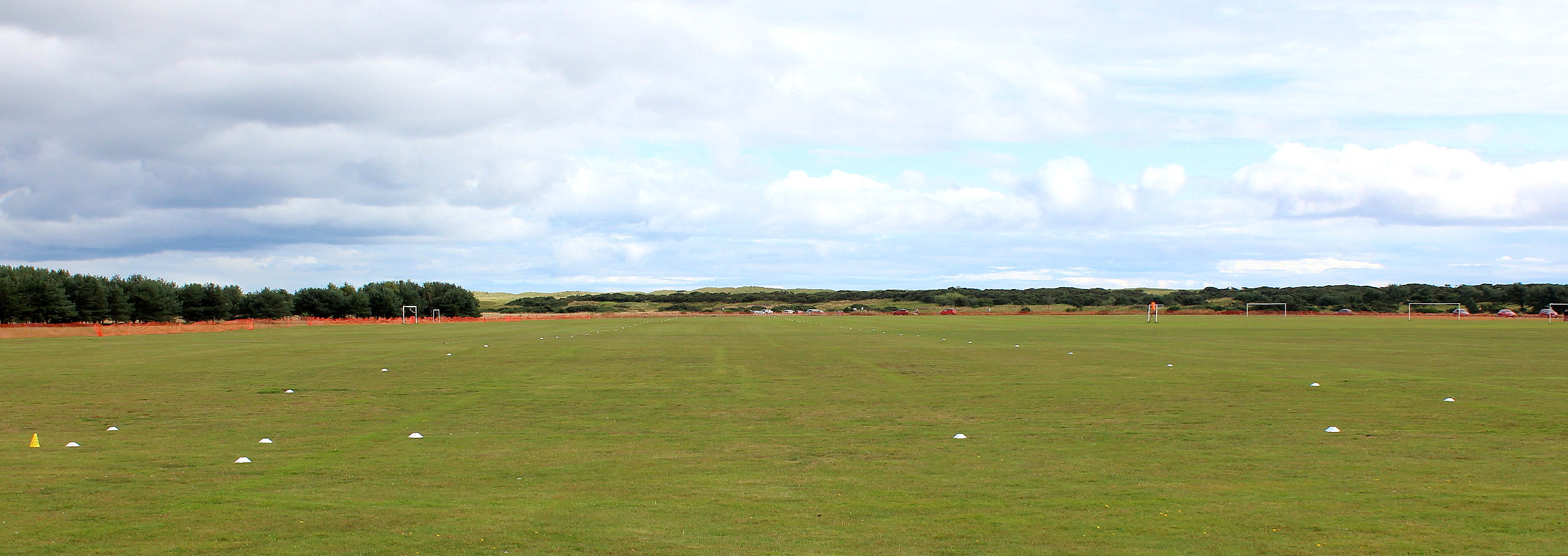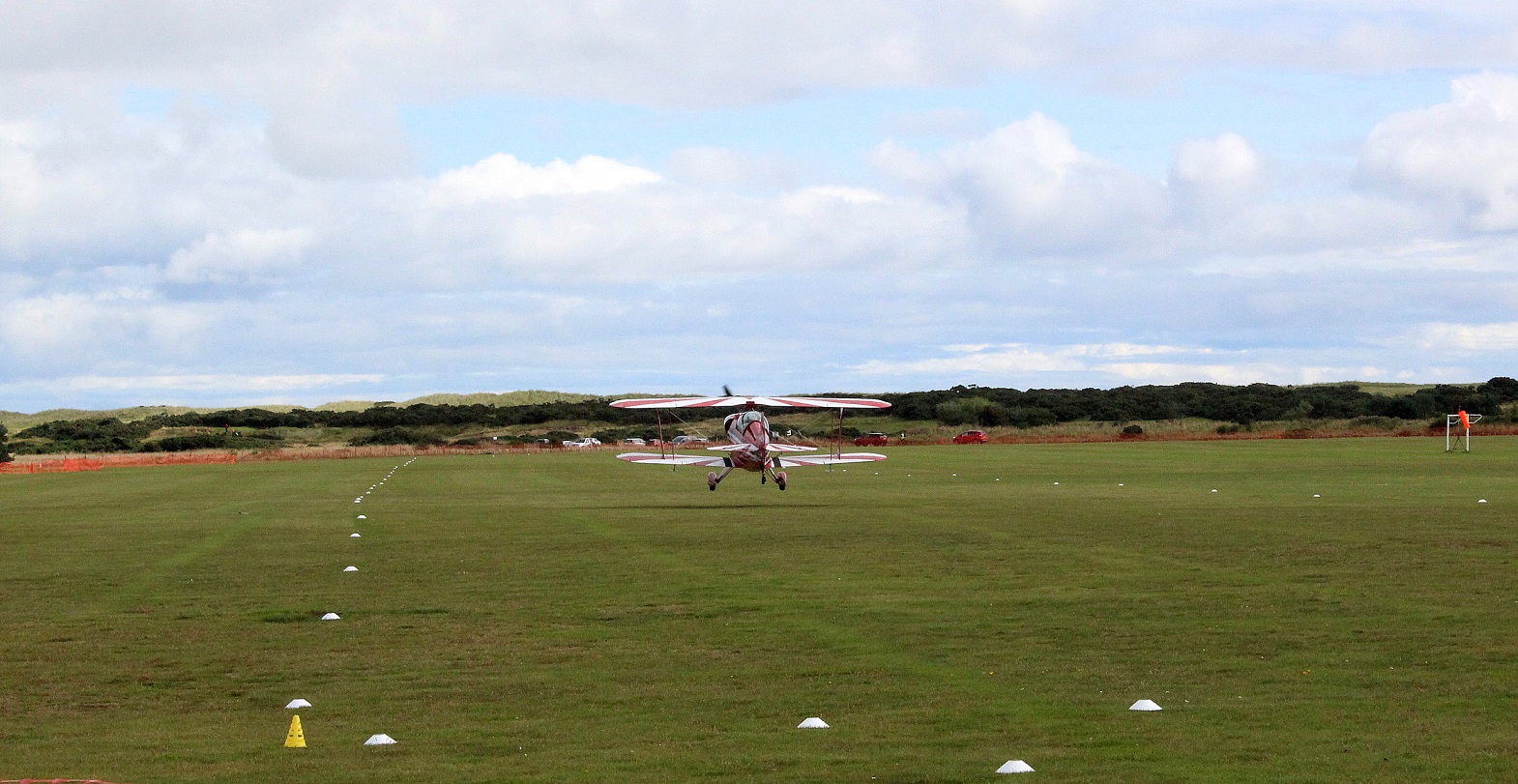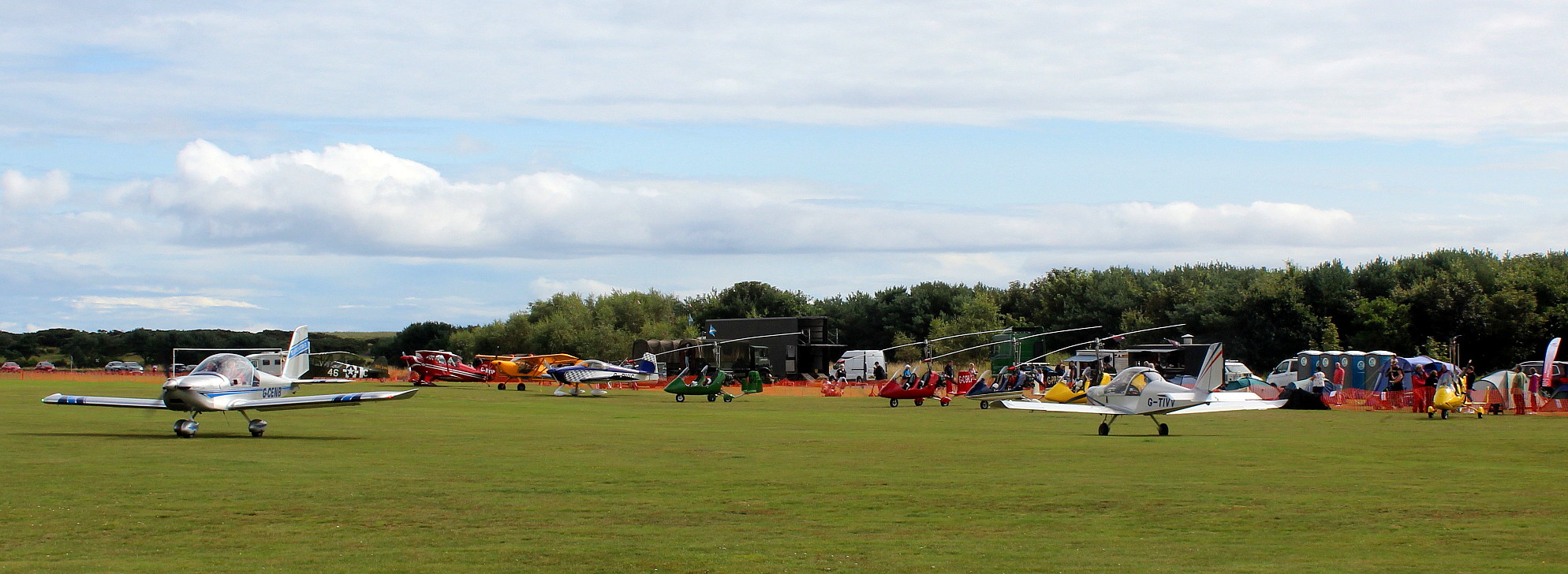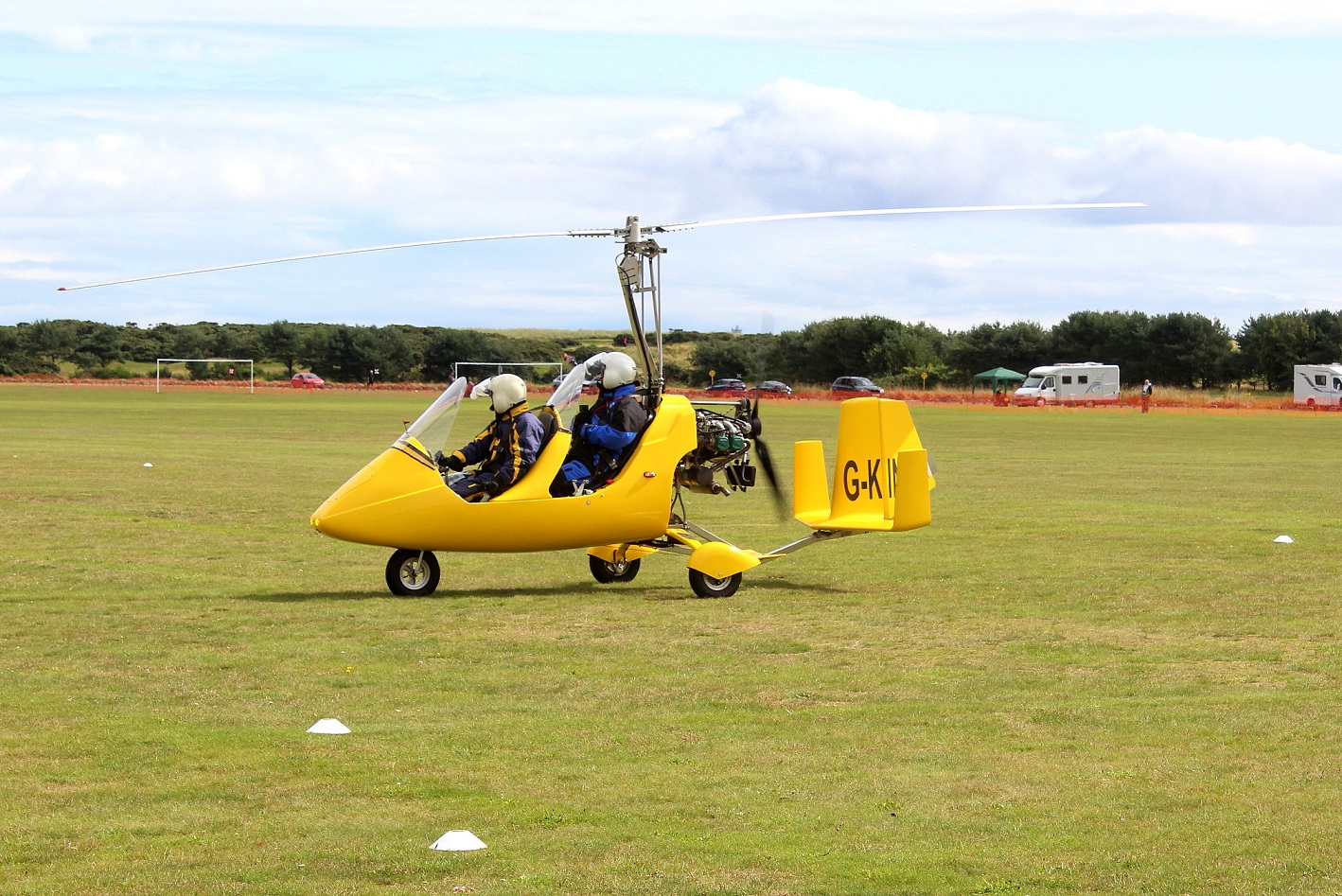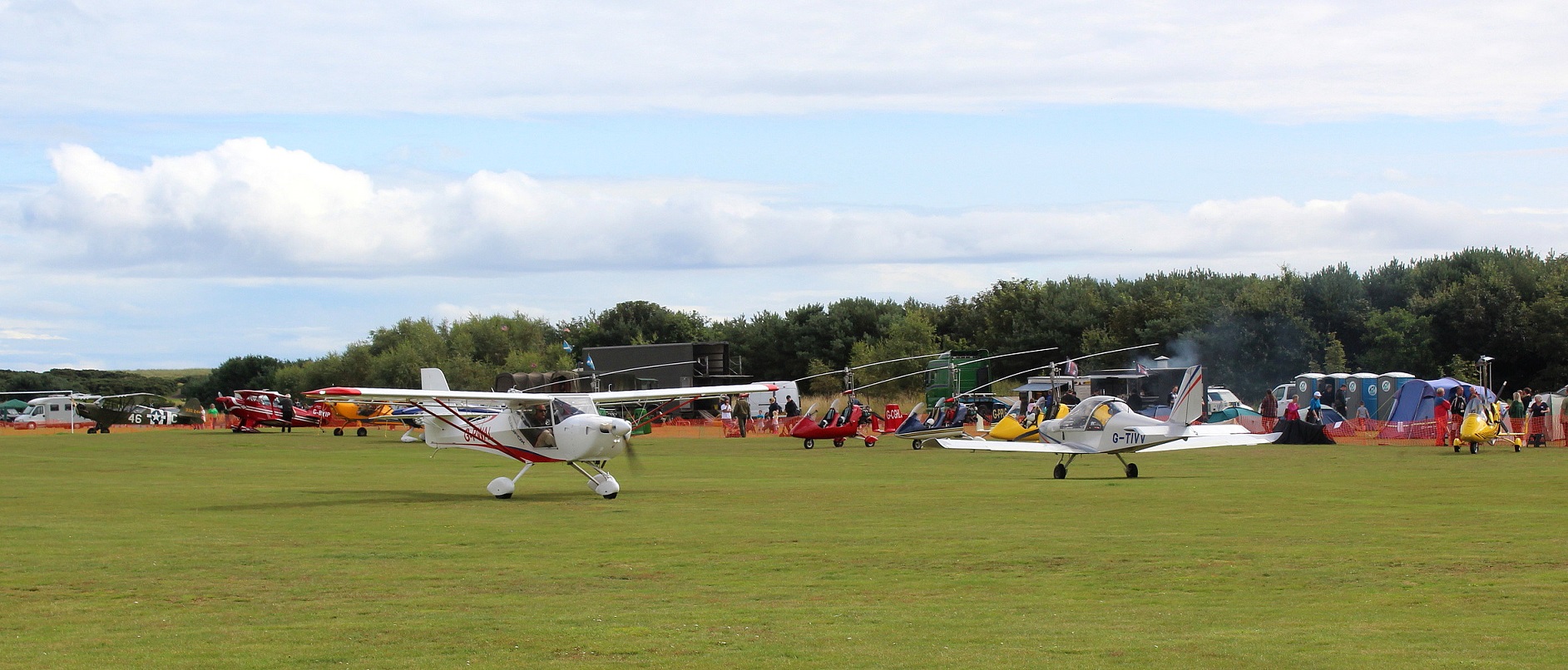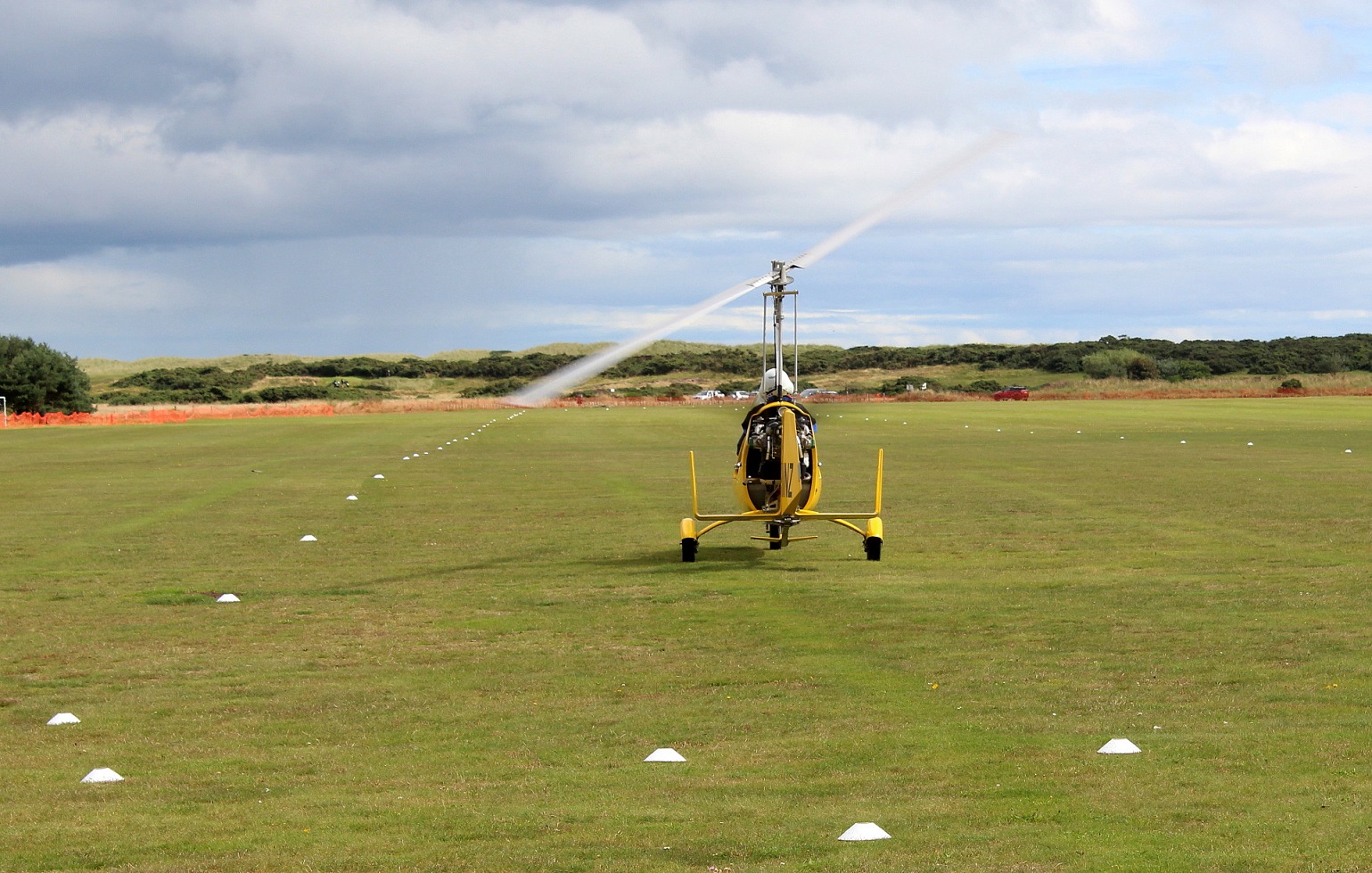Montrose
MONTROSE: Military/ civil aerodrome and possibly civil airport status at one period?
Note: Better known as MONTROSE AIR STATION, and now the location for the Montrose Air Station Heritage Centre. See my article on Museums etc for more pictures.
(The original site was UPPER DYSART FARM but another more suitable nearby site was identified, (this one), originally known as BROOMFIELD and/or BROOMFIELD FARM)
IMPORTANT NOTE
This has been often referred to as being the very first fully operational Royal Naval Air Station in the United Kingdom. IT NEVER WAS! It was first a RFC (Royal Flying Corps) Air Station and remained so during WW1 before becoming, briefly an RAF Air Station. I think the confusion arises by it originally being known as an 'Air Station' prior to WW1. A term later widely adopted in WW1 when the RNAS, (Royal Naval Air Service), were tasked with defending the United Kingdom. The Royal Flying Corps, after training in the U.K., being sent overseas. Not just to Belgium and northern France, but also in the Middle East.
Note: This picture (2006) was obtained from Google Earth ©
The layout of the WW2 airfield can be clearly seen.
Later: Private airstrip
Picture by Austin J Brown:
NOTE: This picture was taken when flying from Dundee to Aberdeen on the 14th October 1992. The wind from the north-west was so strong I was laughing at the drift angle I needed to steer to stay on course, something like 30 degrees, perhaps even more at some stages. And the turbuence was something I had never encountered before. So, top marks to Aussie for taking this picture with the horizon nearly level!
Note: This picture and the two maps were kindly supplied by Mr Michael T Holder. The Territorial Army Camp was held here from May to August.
Military users: Pre WW1: Army (RFC) No.2 Sqdn
WW1: 25, 43, 80 and 83 Sqdns. Also 82 & 85 (Canadian) Reserve Sqdns. No.6, 11, 18 & 39 Reserve Aeroplane Sqdns. No.6, 18 & 39 Training Sqdns. No. 36, 39 & 52 Reserve Sqdns. 41st Aero Sqdn (Pursuit) US Army Air Service, No.26 & 32 Training
Depot Sqdns
NOTE: It of course well known that most RAF aerodromes had a huge amount of aircraft types either based or visiting and this ‘Guide’ couldn’t possibly list all of the types at most of the sites listed. However, I have chosen MONTROSE, which was basically a training ‘Station’ to give some idea of a fairly typical set-up?
Aircraft types used in WW1 at MONTROSE:
In the early days: Henri and also Maurice Farman type machines; Longhorn & Shorthorn.
Avro 504 A/J/K, Royal Aircraft Factory B.E.2b, B.E.2c, B.E.2d & B.E.2e. Later, B.E.12 & B.E.12a, R.E.8, S.E.5 & S.E.5a. Later Bristol Scout C & Scout D, Bristol F2B Fighter, Caudron G111, Curtiss JN3 & JN4.
Plus. Airco (de Havilland) DH.1a, DH.2, DH.4, DH.6 & DH.9. FB9, FE2b, FE2c & FE2e. Martinsyde FK.3, FE.8 & FK.8 Elephant. Sopwith Camel, Pup and “One and a half Strutter”.
BETWEEN THE WARS
From 1936 to WW2: No.8 Flying School (Airspeed Oxford, Hawker Audax)
WORLD WAR II: RAF Flying Training Command 21 Group
8 FTS (Flying Training School)
FIS (Flying Instructors School)
603 Sqdn (Vickers-Supermarine Spitfires)
Aircraft types used at MONTROSE in WW2: Airspeed Oxford & Oxford I, Avro Anson I and Avro Tutor & Tutor I, , Bristol Beaufort IIA, Blenheim 1 & Beaufighter IC, Boultan Paul Defiant I, De Havilland DH.82 Tiger Moth, DH.87 Hornet Moth. Then the Gloster Gauntlet & Gladiator I. Hawker Audax, Fury, Hart Trainer and Hind types seem obvious pre-war types. The Hawker Hurricane 1, IIA, IIB, IIC and Typhoon now seem rather odd types in the training role when only single seat types were available? The arrival of the Lockheed Hudson VI seems interesting to say the least. Possibly the Miles Master I, II and III and especially the Miles Magister aren’t surprising but the North American Harvard IIb surely is in many respects? I suppose the Percival Proctor II might be expected, but was the range of Supermarine Spitfire I, IIA, IIB, VA, VB, VC, VI, XI types expected? And the Walrus? Westland Lysander, II, III & IIIA and Whirlwind I types apparently also featured
RAF Coastal Command
269 Sqdn (Avro Ansons)
POST WW2
Civil Activities: Post 1945: Charter mail flights during the 1970s
Charter users: Post 1945: Assistair
Location: E of A921, 1nm NNE of Montrose
Period of operation: 1913 to 1920. Apparently used by one of the Cobham Tours in 1932 then military again from 1936 to 1945. There are a few records of the site being used on a graduallydiminishing ad-hoc basis for some GA activities since 1945.
Runways: Originally ‘all over’ grass aerodrome
WW2: (With steel matting) 04/22 1216 grass 07/25 914 grass 17/35 700 grass
A MIKE CHARLTON GALLERY
MONTROSE IN THE EARLY YEARS
The Notice of the move of No.2 Squadron from UPPER DYSART to the new RNAS aerodrome at MONTROSE was published in the Dundee Courier on the 11th December 1913. In effect No.2 Squadron was diverted to UPPER DYSART using tented accommodation, including the hangars, whilst MONTROSE was under construction and being finished off.
MONTROSE IN THE 1920s & 30s
LAST BUT NOT LEAST
Note: This fabulous collection of pictures from postcards have been very kindly supplied by Mike Charlton who has an amazing collection. See, www.aviationpostcard.co.uk
Second, third and fourth pictures: It looks to me, in the second picture, like the B.E.2 type seen flying has been superimposed in the darkroom. An early example of 'Special Effects'. And indeed, possibly the same applies to the third and fourth pictures, which, as you will see, are identical except for the aircraft flying. Probably the sixth picture too?
In the third and fourth pictures we can see, on the ground, the Royal Aircraft Factory B.E.2a of 3 Squadron (serial No. 272) and the Maurice Farman S,7 Longhorn (serial No.215).
I think it is interesting to see, even during the early years of WW1, that the very basic Farman types were still being used, presumably for basic training duties.
Fifth picture: This picture shows, in the foreground, the Royal Aircraft Factory B.E.2a, serial No. 332. Can this be dated?
Seventh, ninth and eleventh pictures. If anybody can kindly offer advice regarding the aircraft types depicted here, this will be most welcome. I am not very good at this era - show me a Spitfire, Meteor, Hunter or Vulcan and I'm very happy, but for this era I really do not have the expertise. However, they mostly appear to be examples of the Hawker Hart 'range' which includes the Audax, Demon and Hart. As noted elsewhere, (above), it appears that the Audax was certainly in service here.
Rather oddly perhaps, and I cannot claim to have spent days on searching, a trawl across the internet did not reveal any of these, especially the Audax which I focused on, being recorded at MONTROSE. Which is exactly why I still read books.
Regarding the twelth picture, I think the thin chimney 'stacks' are worth a mention. Without too much doubt these were connected to free-standing coal-fired heaters, possibly doubling as ovens with a hot-plate to heat water for tea making and providing hot water for washing and shaving. Seeing the spacing, (one per room?), it can be imagined that they were probably quite adequate even in the depths of winter.
The thirteenth picture is interesting for several reasons. If it is from the 1970s it probably shows the Miles Magister R1914 (G-AHUJ) on a visit when it was being flown from the Stathallen Collection. The tail of the Fairey Gannet XE340 it a T.5 example.
In the bottom left-hand is a picture of what I think is a Bedford RLHZ Self Propelled Pump, commonly known as a 'Green Goddess'. A couple of thousand were produced, powered by just a 4.9litre petrol engine developing at best, 110bhp. Hardly the 'Rapid Response' type vehicle we expect today to come to the rescue. Quite probably having the performance some lorry drivers described to me some fifty years ago? "It can't pull the skin off a rice pudding."
FOUR MORE PICTURES
The first picture is another composite item, or trick photo. The 'airborne' BE.2 being added later to the negative in the darkroom. The second aerial picture is from WW1 and the third picture was taken c.1942. The fourth aerial picture, taken in 1977, is courtesy of the Van Werninck Studio. All four are of pictures on display in the Heritage Centre during August 2023.
NOTES: MONTROSE was, it seems, the first operational Air Station in the UK. The first site being at UPPER DYSART FARM in 1913. It appears that on the 13th February 1913 No.2 Squadron, (comprising five aircraft), left FARNBOROUGH under the command of Major C J Burke for MONTROSE with two BE 2s and three Maurice Farman types. The story is told that the first to arrive in the region, on the 26th February, actually landed in the grounds of the Sunnyside Royal Hospital at Hillside. It seems that eventually thirteen aircraft arrived.
The first official record I found was when John Mead (Sergeant) was awarded his Pilot Certificate No.475 on 2/5/13 flying a Maurice Farman Biplane from here.
Also in 1913 No.2 Squadron were detailed to fly to Ireland to take place in army manoeuvres. It is said that only two aircraft were lost on this exercise.
The move from UPPER DYSART to BROOMFIELD seems to have occurred at the end of 1912.
A MAJOR RECORD FLIGHT
This photo of Capt. C.A.H. Longcroft, albeit on a Farman type, was obtained from The History of British Aviation 1908 to 1914 by R. Dallas Brett.
In 2017 I came across this account in the excellent book; British Aviation - The Pioneer Years, by Harald Penrose, first published in 1967. He tells us; "As an exercise in discovering long-distance potentialities, one of the Renault-powered 70 h.p. B.E.2s, built for the R.F.C. by the British & Colonial Aeroplane Co,. (My note: Later Bristol), was fitted at Montrose with a large fuel tank of 54 gallons. Piloted by Capt. Longcroft, star of No.2 Squadron, again with Col. Sykes as Observer, he was despatched southward to Farnborough, then, without stopping, to Portsmouth and back to Farnborough, where he landed after 7¼ hrs, having covered some 600 miles non-stop at over 80 m.p.h. - the longest cross-country flight yet made carrying a passenger"
"As a result Longcroft was awarded the annual Britannia trophy presented by Mr. Horatio Barber for the most meritorious performance by a British pilot during the current year."
WORTHWHILE INFORMATION
It is well worth getting a copy of “Montrose Airfield from 1913” from the museum now based there. It really does give a very “down to earth” account about how so many RFC/RAF aerodromes functioned in both the World Wars. Perhaps, for this ‘Guide’ especially, this section of Major C J Burkes many reports in WW1 is of considerable importance. “Temporary Landing Grounds are very useful for training purposes, and steady practice in landing away from home, under favourable circumstances, helps to save machines”.
Note the emphasis on saving machines, not pilots! “To carry this out I have had a landing ground system in operation since arrival, and which has cost nothing”. “That such facilities have been available is certainly a factor in favour of this place”. The report goes on, “I append four examples of how landing grounds are obtained and noted. We have a selection of landing grounds all round Montrose, and hope to get the whole district mapped out”. I suppose it doesn’t really matter in the great scheme of things, but, perhaps a copy of these ‘Temporary Landing Grounds’ report still exists in official archives?
It is well worth telling that one aspect of Major Burke’s legacy still survives today. These are the 1913 ‘Major Burke’s Sheds’ a type of building later classified as hangars from the French term for such structures of course. The southernmost ‘Shed’ is now a class ‘A’ listed building and still largely in original condition. When WW1 ended the equipment, aircraft and stores were moved to FIFE to help start up RAF LEUCHARS.
GHOST STORIES
Another fairly rare aspect compared to other military airfields is that MONTROSE seems to have a propensity to generate ghost stories. The story of a Hurricane pilot in WW2 going around twice when attempting to land at night because a biplane was blocking the runway certainly gives the ‘shivers’. Many perplexed ground staff witnessed this happenining and when eventually landing the very irate pilot was informed, “There are no biplanes based on this airfield!”
FLYING CIRCUS VENUE
The 1932 itinerary for Alan Cobham’s National Aviation Day UK Display Tour gives, as their 150th venue on the 27th September, ‘The Aerodrome’ Montrose. Mike Holder unearthed this account from the Montrose Standard, published on Friday 30th September 1932:
TWO 'PLANES IN CONTACT.
________
Accident During Formation Flight.
"During the aviation display on Tuesday a mishap occurred during the formation flight which might have had tragic consequences. A three-engined passenger 'plane and a black monoplane came into contact with each other and considerable damage was caused to the wings. The two 'planes immediately returned to the aerodrome and landed safely. The passengers were transferred to other aeroplanes and took part in the formation flight. Hon. Treasurer Boutar was one of the passengers in the big 'plane and saw the whole happening."
The "three-engined passenger 'plane" was one of two Airspeed Ferrys operated by Cobham. The "black monoplane" can only be guessed at? If pushed to hazard a guess - perhaps the Comper Swift G-ABPY? What is very notable about this incident is that it was one of very few that have been recorded. The safety record of both Cobham's and the other 'Flying Circus' operators seems remarkably good, especially even by modern air display standards.
1944
During late 1944, 1544 RAF plus 251 WAAF personnel were based here so it was obviously a pretty major training base during that period.
THE MOUNTAIN RESCUE TEAMS
On a more general theme it seems the very first volunteer Mountain Rescue Team was established here in 1944, an organisition that has served aviation interests very well indeed, sometimes if only rarely bringing in survivors of aircraft crashes but sadly and essentially more often as not, retrieving the remains.
PRIVATE AIRSTRIP
In the Pooleys Flight Guide published in 1993, a private strip operated by Mr N Smart, Joseph Johnston & Sons, appears to be operating here.
The runway is described as: 04/22 730x42 grass on tracking
A VISIT IN AUGUST 2023
Whilst on holiday near Arbroath, I had the good fortune to plan a visit to the Montrose Air Station Heritage Centre on the 27th August. To my delight this coincided with an open weekend when a Fly-In was taking place. It had been very busy on the 26th but poor weather to the north prevented many aircraft flying in on the 27th. These Fly-Ins have been taking place since the 1980s and help to maintain the location as a flying site with regard to planning stipulations.
Runway: 07/25 500 grass
Picture One shows the Pitts S-2A, G-BYIP (ex N109WA), about to touch down. Picture Two shows the line up of visiting aircraft.
Picture Three is of the Rotorsport UK MTOSPORT G-KINZ. Picture Four shows the Eurofox 912(1) G-PWAL arriving, with to the right, the Aerotechnik EV-97 Eurostar G-TIVV.
Picture Five shows G-KINZ, with rotor wound up, starting its take-off run. The continued development of gyrocopters in recent years has been quite astonishing. Starting off with very basic airframes, and it has to said, a very poor safety record, today they are very safe machines. And indeed, there are two seater types with an enclosed cabin, suitable for touring with.
Dr Daniel Paton
This comment was written on: 2016-07-06 22:31:14I am curator at Montrose Air Station Heritage Centre. The comments are very interesting and generally correct. The huge range of aircraft is bit misleading. The museum has hugely expanded in recent years and is now accredited. It is well worth a visit by aviation enthusiasts.
We'd love to hear from you, so please scroll down to leave a comment!
Leave a comment ...
Copyright (c) UK Airfield Guide















